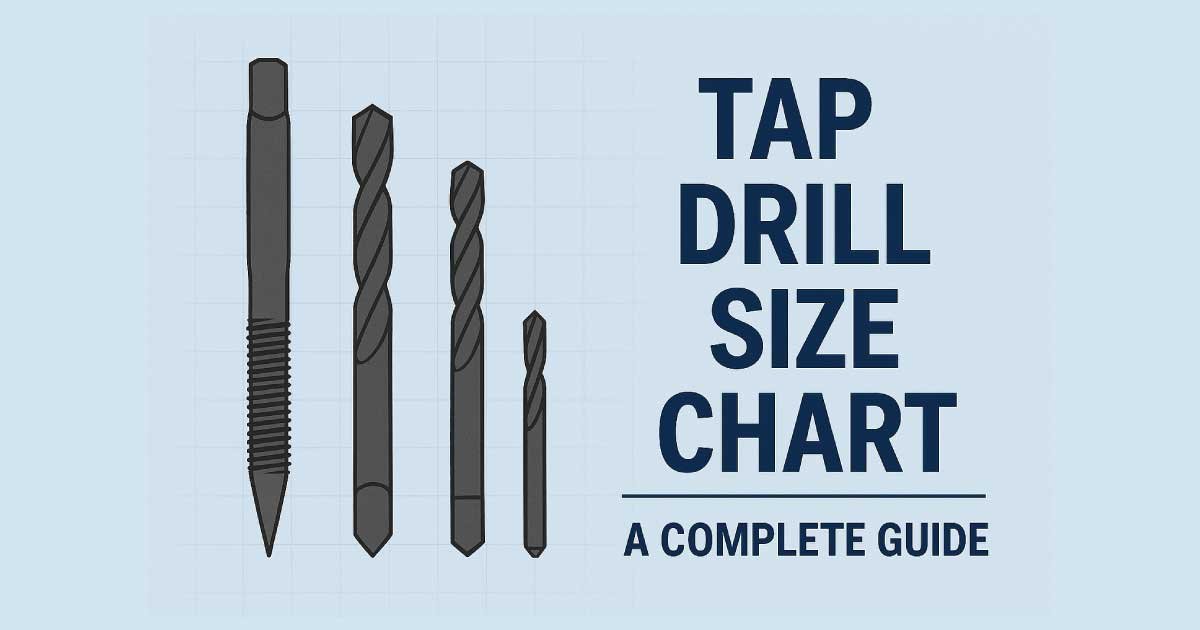When it comes to making precise screw threads in metal, plastic, or wood, accuracy is everything. If the drilled hole is too small, the tap may break. If it’s too large, the threads won’t hold. That’s why professionals and hobbyists rely on the tap drill size chart — a quick reference that matches tap sizes with the correct drill bit sizes.
In this detailed guide, we will cover everything you need to know about tap drill sizes, show you complete inch and metric charts, and share practical tips so you can achieve perfect threads every time.
What Is a Tap Drill?
A tap drill is the hole you drill before cutting internal threads with a tap. Think of it as the foundation for threading. Without the correct hole size, the tap cannot cut clean threads, which can result in weak fasteners, stripped holes, or broken taps.
For example:
If the hole is too small, tapping becomes difficult and the tool may snap.
If the hole is too large, the threads will be too shallow and won’t grip properly.
That’s why knowing the right size is critical.
Why a Tap Drill Size Chart Matters
A tap drill size chart is more than just a reference — it’s a time-saving and error-preventing tool. Instead of calculating each hole size manually, machinists simply check the chart and pick the right drill bit.
Benefits of using a tap drill chart:
Ensures proper thread engagement (stronger connections).
Reduces the risk of broken taps.
Extends the life of drill bits and taps.
Saves time during machining or DIY work.
Works for both imperial (inch) and metric fasteners.
Whether you’re threading a hole for an M6 machine screw in a steel plate or tapping for a 1/4″-20 UNC bolt in aluminum, a quick look at the chart ensures you don’t waste material or tools.
Tap Drill Size Formula
Charts are convenient, but sometimes you may need to calculate the size yourself. The formula is straightforward:
Formula (for ~75% thread depth):
Where:
Major Diameter = the nominal size of the screw.
Pitch = the distance between threads.
👉 Example: For a 1/4″-20 UNC tap:
Major Diameter = 0.250″
Pitch = 1/20 = 0.050″
Tap Drill Size = 0.250 – 0.050 = 0.200″ → closest drill = #7 (0.201″)
This calculation works for both metric and inch taps, though most machinists prefer to use a ready chart.
🛑 Don’t miss this — 👉🪛Detailed Screw Measurement Guide helps you pick the right length, diameter, and thread for every project. Perfect for builders, carpenters, and DIY experts aiming for precision and strength!
Tap Drill Size Chart (Inch)
Here’s a chart for common UNC (coarse) and UNF (fine) taps:
| Tap Size | Threads per Inch (TPI) | Major Diameter (in) | Drill Size | Decimal (in) |
|---|---|---|---|---|
| #0-80 UNC | 80 | 0.0600 | #56 | 0.0465 |
| #2-56 UNC | 56 | 0.0860 | #50 | 0.0700 |
| #4-40 UNC | 40 | 0.1120 | #43 | 0.0890 |
| #6-32 UNC | 32 | 0.1380 | #36 | 0.1065 |
| #8-32 UNC | 32 | 0.1640 | #29 | 0.1360 |
| #10-24 UNC | 24 | 0.1900 | #25 | 0.1495 |
| #10-32 UNF | 32 | 0.1900 | #21 | 0.1590 |
| 1/4″-20 UNC | 20 | 0.2500 | #7 | 0.2010 |
| 1/4″-28 UNF | 28 | 0.2500 | #3 | 0.2130 |
| 5/16″-18 UNC | 18 | 0.3125 | F | 0.2570 |
| 5/16″-24 UNF | 24 | 0.3125 | I | 0.2720 |
| 3/8″-16 UNC | 16 | 0.3750 | 5/16″ | 0.3125 |
| 3/8″-24 UNF | 24 | 0.3750 | Q | 0.3320 |
| 1/2″-13 UNC | 13 | 0.5000 | 27/64″ | 0.4219 |
| 1/2″-20 UNF | 20 | 0.5000 | 29/64″ | 0.4531 |
Tap Drill Size Chart (Metric)
Metric threads are just as common, especially in automotive and European machinery. Here’s the standard chart:
| Tap Size (mm) | Pitch (mm) | Major Diameter (mm) | Drill Size (mm) |
|---|---|---|---|
| M2 x 0.4 | 0.4 | 2.0 | 1.6 |
| M3 x 0.5 | 0.5 | 3.0 | 2.5 |
| M4 x 0.7 | 0.7 | 4.0 | 3.3 |
| M5 x 0.8 | 0.8 | 5.0 | 4.2 |
| M6 x 1.0 | 1.0 | 6.0 | 5.0 |
| M8 x 1.25 | 1.25 | 8.0 | 6.8 |
| M10 x 1.5 | 1.5 | 10.0 | 8.5 |
| M12 x 1.75 | 1.75 | 12.0 | 10.2 |
| M16 x 2.0 | 2.0 | 16.0 | 14.0 |
| M20 x 2.5 | 2.5 | 20.0 | 17.5 |
Tap Drill Size Chart, Inch, Metric ( Free, Printable, Pdf)
Download This Pdf Of Tap Drill Size Chart:
Different Types of Taps and Their Use
To use the chart effectively, you should know the types of taps available:
Taper Tap – Easy starting, used for through holes.
Plug Tap – General-purpose, most commonly used.
Bottoming Tap – For blind holes where full threads are required.
Spiral Point Tap – Designed for production, pushes chips forward.
Spiral Flute Tap – Best for blind holes, pulls chips out of the hole.
Choosing the right tap plus the right drill size ensures clean and durable threads.
Applications of Tap Drill Charts
Tap drill charts are used in many industries:
Automotive repair: Threading for bolts and studs in engines.
Aerospace: Precision tapping in lightweight alloys.
Plumbing: Creating threaded pipe fittings.
DIY workshops: Making threads in wood, plastic, or metal.
Manufacturing: Mass production of threaded components.
In all these cases, consistency is key — which is why charts are essential.
Tips for Successful Tapping
Always use cutting fluid for lubrication.
Drill at the recommended speed — slower for harder materials.
Frequently back out the tap to clear chips.
Avoid forcing the tap; if resistance is high, recheck hole size.
Use a proper tap wrench for alignment.
Safety Precautions
Tapping may seem simple, but mistakes can lead to injuries or broken tools. Keep these safety rules in mind:
Wear safety goggles to protect your eyes from chips.
Use sharp, undamaged taps and drills.
Secure the workpiece firmly before drilling.
Avoid using high-speed drills for tapping — it increases breakage risk.
Troubleshooting Common Issues
Threads are too loose → Hole drilled too large; check chart again.
Tap breaks during cutting → Hole is too small, or chips are not clearing.
Rough threads → Tap is worn out or cutting fluid wasn’t used.
Misaligned threads → Drill was not perpendicular to surface.
⚠️ Pay attention to every connection — 👉 ⚙️ Complete Washer Size Guide shows you the right inner and outer diameters for secure and balanced fastening. Perfect for engineers, mechanics, and DIY enthusiasts who want precision in every project!
Conclusion
A tap drill size chart is one of the most important references in machining, fabrication, and repair work. It ensures accurate, clean, and strong threads every time. With both inch and metric charts in hand, you can confidently drill and tap for any project, whether it’s automotive repair, DIY furniture, or industrial manufacturing.
Print a copy of this chart and keep it in your toolbox or workshop — it will save you from countless mistakes and broken taps.

